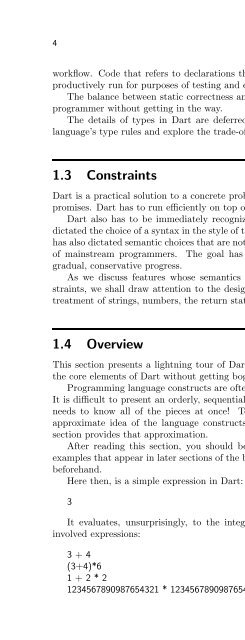The Dart Programming Language
VRig8
VRig8
Create successful ePaper yourself
Turn your PDF publications into a flip-book with our unique Google optimized e-Paper software.
4 Chapter 1 Introduction<br />
workflow. Code that refers to declarations that are absent or incomplete may still be<br />
productively run for purposes of testing and experimentation.<br />
<strong>The</strong> balance between static correctness and flexibility allows the types to serve the<br />
programmer without getting in the way.<br />
<strong>The</strong> details of types in <strong>Dart</strong> are deferred until Chapter 5, where we explain the<br />
language’s type rules and explore the trade-offs alluded to above in detail.<br />
1.3 Constraints<br />
<strong>Dart</strong> is a practical solution to a concrete problem. As such, <strong>Dart</strong>’s design entails compromises.<br />
<strong>Dart</strong> has to run efficiently on top of web browsers as they exist today.<br />
<strong>Dart</strong> also has to be immediately recognizable to working programmers. This has<br />
dictated the choice of a syntax in the style of the C family of programming languages. It<br />
has also dictated semantic choices that are not greatly at variance with the expectations<br />
of mainstream programmers. <strong>The</strong> goal has not been radical innovation, but rather<br />
gradual, conservative progress.<br />
As we discuss features whose semantics have been influenced by the above constraints,<br />
we shall draw attention to the design trade-offs made. Examples include the<br />
treatment of strings, numbers, the return statement and many more.<br />
1.4 Overview<br />
This section presents a lightning tour of <strong>Dart</strong>. <strong>The</strong> goal is to familiarize you with all<br />
the core elements of <strong>Dart</strong> without getting bogged down in detail.<br />
<strong>Programming</strong> language constructs are often defined in a mutually recursive fashion.<br />
It is difficult to present an orderly, sequential explanation of them, because the reader<br />
needs to know all of the pieces at once! To avoid this trap, one must first get an<br />
approximate idea of the language constructs, and then revisit them in depth. This<br />
section provides that approximation.<br />
After reading this section, you should be able to grasp the essence of the many<br />
examples that appear in later sections of the book, without having read the entire book<br />
beforehand.<br />
Here then, is a simple expression in <strong>Dart</strong>:<br />
3<br />
It evaluates, unsurprisingly, to the integer 3.<br />
involved expressions:<br />
And here are some slightly more<br />
3 + 4<br />
(3+4)*6<br />
1 + 2 * 2<br />
1234567890987654321 * 1234567890987654321


